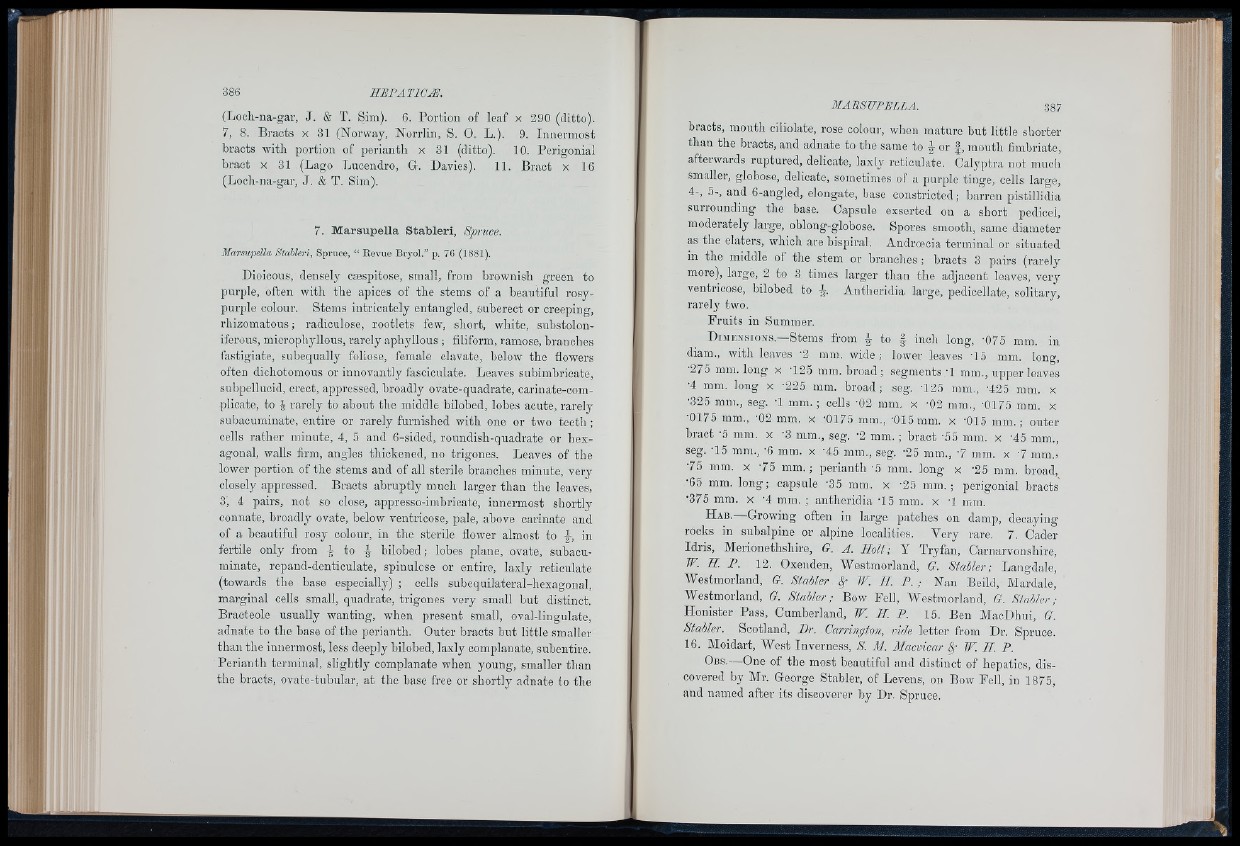
(Loch-na-gar, J. & T. fyni). 6. Portion of leaf x 290 (ditto).
7, 8. Bracts x 31 (Norway, Norrlin, S. 0 . L.). 9. Innermost
bracts with portion of perianth x 31 (ditto). 10. Perigonial
braot X 31 (Lago Luoendro, G. Davies). 11. Braot x 16
(Loch-na-gar, J. & T. Sim).
7. Marsupella Stabler!, Sqaruce.
Marsupella Stableri, Spruce, “ Reviie Bryol.” p. 70 (1881).
Dioicous, densely cæspitose, small, from brownish green to
purple, often with the apices of the stems of a beautiful rosy-
purple colour. Stems intrioately entangled, suberect or creeping,
rhizomatous ; radiculose, rootlets few, short, white, substolon-
iferous, microphyllous, rarely aphyllous ; filiform, ramose, branches
fastigiate, subequally foliose, female clavate, below the flowers
often dichotomous or innovantly fasciculate. Leaves subimbricate,
subpelluoid, erect, appressed, broadly ovate-quadrate, carinate-oom-
plicate, to J rarely to about tlie middle bilobed, lobes acute, rarely
subacuminate, entire or rarely furnished with one or two teeth ;
cells rather minute, 4, 5 and 6-sided, roundish-quadrate or liex-
agonal, walls firm, angles thickened, no trigones. Leaves of the
lower portion of the stems and of all sterile branches minute, very
closely appressed. Bracts abruptly mucli larger than the leaves,
3, 4 pairs, not so close, appresso-imbricate, innermost shortly
connate, broadly ovate, below ventricose, pale, above carinate and
of a beautiful rosy colour, in the sterile flower almost to in
fertile only from -J to ^ bilobed ; lobes plane, ovate, subaouminate,
repand-dentioulate, spinulose or entire, laxly reticulate
(towards the base especially) ; cells subequilateral-hexagonal,
marginal cells small, quadrate, trigones very small but distinct.
Bracteole usually wanting, when present small, oval-lingulate,
adnate to the base of the perianth. Outer bracts but little smaller
than the innermost, less deeply bilobed, laxly complánate, subentire.
Perianth terminal, slightly complánate when young, smaller than
the bracts, ovate-tubular, at the base free or shortly adnate to the
bracts, mouth ciliolate, rose colour, when mature but little shorter
than the bracts, and adnate to the same to | or f , mouth fimbriate,
afterwards ruptured, delicate, laxly reticulate. Calyptra not much
smaller, globose, delicate, sometimes of a purple tinge, cells large,
4-, 5-, and 6-angled, elongate, base constricted ; barren pistillidia
surrounding the base. Capsule exserted on a short pedicel,
moderately large, oblong-globose. Spores smooth, same diameter
as the elaters, which are hispiral. Androeoia terminal or situated
m the middle of the stem or branohes ; bracts 3 pairs (rarely
more), large, 2 to 3 times larger than the adjacent leaves, very
ventricose, bilobed to 4, Antheridia large, pedicellate, solitary,
rarely two.
Fruits in Summer.
D i m e n s i o n s .— Stems from J to f inch long, 075 mm. in
diam,, with leaves '2 mm. wide; lower leaves T5 mm. long,
'275 mm. long x T25 mm. broad ; segments'! mm., upper leaves
'4 mm. long x '225 mm. broad; seg. '125 mm., '425 mm. x
'325 mm., seg. '1 mm. ; cells '02 mm, x '02 mm., '0175 mm. x
'0175 mm., '02 mm. x '0175 mm., '015mm. x '015 mm.; outer
bract '5 mm. x '3 mm., seg. '2 mm. ; bract '55 mm. x '45 mm.,
seg. '15 mm., '6 mm. x '45 mm., seg. '25 mm., '7 mra. x '7 mm.!
75 mm. x '75 mm.; perianth '5 mm. long x '25 mm. broad,
'65 mm, long; capsule '35 mm. x -25 mm.; perigonial bracts
'375 mm. x '4 mm. ; antheridia '15 mm. x '1 mm.
H a b .—Growing often in large patches on damp, decaying
rocks in subalpine or alpine localities. Very rare. 7. Cader
Idris, Merionethshire, G. A. Holt; Y Tryfan, Carnarvonshire,
W. H P. 12 . Oxenden, Westmorland, G. Stabler; Langdale,
Westmorland, G. Stabler fl W. H. P .; Nan Beild, Mardale,
Westmorland, G. Stabler ; Bow Fell, Westmorland, G. Stahler ;
Honister Pass, Cumberland, W. II. P. 15. Ben MacDhui, G.
Stabler. Scotland, Dr. Carrington, vide letter from Dr. Spruce.
16. Moidart, West Inverness, S. M. Macvicar fl W. II. P.
O b s.— One of the most beautiful and distinct of hepatics, discovered
by Mr. George Stabler, of Levens, on Bow Fell, in 1875,
and named after its discoverer by Dr. Spruce.